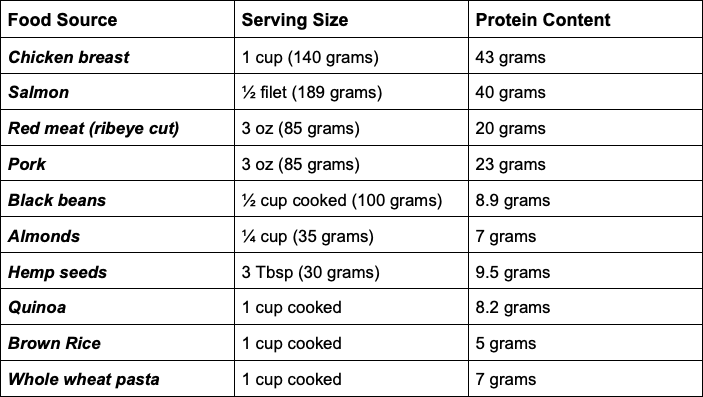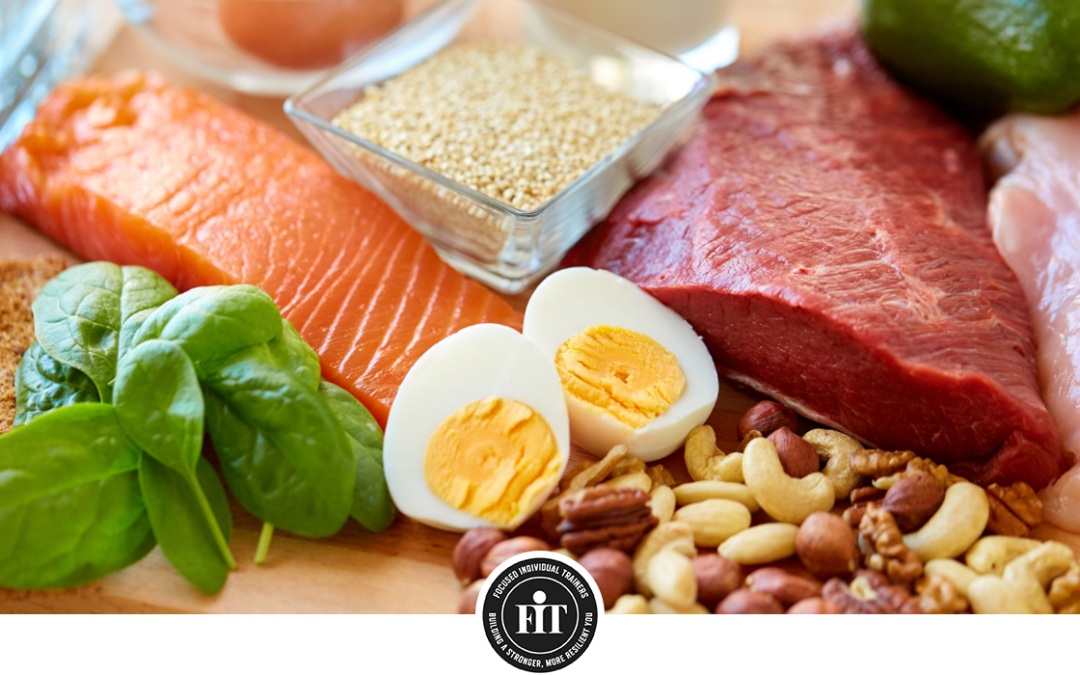As we embark upon changing body composition, creating healthier habits, exploring more sustainable and well-rounded eating choices, and improving overall health, we must consider one of the most important factors – eating strategy.
Specifically, protein is the macronutrient that is critical for our performance, recovery, and physical integrity. At FiT, we consider eating strategy to be one of our five pillars of health optimization, where we approach food in a strategic and scientific manner. Different from dieting, eating strategy implies a well-thought out solution to address nutritional needs, fitness goals, health considerations, and client intuition around food.
A strategy for one person might not be the best strategy for the next person, lending to unique eating strategies for each individual and their needs. Many “diets” focus on manipulating the percentages of each macro to hack physiology; keto doesn’t allow for more than 50 grams of carbs per day and emphasizes higher dietary fat intake. A low fat diet doesn’t allow for more than 35-40 grams of fat per day. Paleo prioritizes increased protein and fat with very little carbs, and so on and so forth. These diet extremes are not sustainable and generally end up negatively affecting body composition unless they’re executed well and under the supervision of a trained professional.
Balanced eating habits, such as the Mediterranean diet, DASH diet, and whole foods diet, all of which include healthy fats, lean protein, substantial fiber, and balanced macro- and micro-nutrient profiles, lead to more success in body composition changes and increased health benefits. Just as macro-nutrient (carbs, fats, proteins) distribution is important, micro-nutrient intake helps to support and optimize your physiology – this includes vitamins, minerals, and antioxidants naturally found in fruits, vegetables, medicinal herbs, and supplements.
Macronutrients and Digestion
When it comes to eating, consistency is key. Consider our three macronutrients – carbohydrates, protein, and fat. Carbohydrates are used for energy (and eventually made into stored energy as fat), protein is used for building and repair, and fat is used for cell integrity, nervous system support, and high-octane energy. These macronutrients make up the vast majority of our meals, and when their ratios are balanced, we see results.
The protein we eat starts digestion in the stomach, as stomach acid activates the enzymes necessary for breaking down protein into simpler structures. This process produces individual amino acids that are essential for tissue repair and integrity, neurotransmitter health and signaling, blood cell enrichment, the list goes on. Once absorbed, most of these proteins require some level of processing via the liver before they can be used throughout the body; however, there are three amino acids that do not require any processing by the liver and can be used directly (kind of like TSA pre-check) for muscle repair, energy, and nervous system support. These amino acids are called branch chain amino acids or BCAAs (you may have heard of them as a popular exercise supplement).
Our body also has the ability to make some amino acids, as long as we provide the proper building blocks. Out of the 20 common amino acids found in the human body, nine are “essential” as they cannot be made by the liver and must be acquired through your diet.
Amino Acids (bolded are essential amino acids; *BCAAs)
- Arginine
- Asparagine
- Aspartic Acid (Aspartate)
- Lysine
- Histidine
- Valine*
- Leucine*
- Iso-leucine*
- Serine
- Threonine
- Glutamine
- Glutamic Acid (Glutamate)
- Cystine
- Glycine
- Proline
- Alanine
- Methionine
- Phenylalanine
- Tyrosine
- Tryptophan
Dietary Sources of Protein and Protein Digestion
Common protein sources include animal tissues, legumes, nuts and seeds, grains, and dairy products. Yes, I said tissues! The liver, heart, tongue, and tendons (you name it!) all contain a good amount of protein in addition to the unique nutrients found in each. Legumes and grains mixed together have the same amino acid profile as meat, meaning it contains the essential AAs that our bodies cannot manufacture themselves.
Additionally, the order in which we eat our macros can determine how our body handles the incoming nutrients, and many practitioners and nutritionists generally recommend eating protein and fat first, then carbohydrates. This has been shown to slow down the digestion of carbohydrates.
With those struggling with insulin resistance, metabolic syndrome, or blood sugar spikes and crashes, it can make a significant difference in energy level and blood sugar stability. As far as portioning protein, prioritizing 30-40 grams of protein per meal will generally help to meet your protein goal.

With nutrition, it’s important to diversify sources of each of our macronutrients, so I recommend exploring different protein types. So then comes the question – how much protein should I eat? For an adult who is relatively active, generally the following equation is used:
Daily protein recommendation = 1 gram protein per pound body weight
But this can (and should) be adjusted for gender, age, training frequency, athletic season, injury status, weight management goals, and hormone status. To be more specific, use the following guidelines..
Female daily protein recommendation = 0.75-1.5 g protein per pound body weight
For example, a 150 pound female athlete who is about to or is currently ovulating should eat more protein (~1.3-1.5 g/# bw) than when she is about to start her cycle (~0.75-85 g/# bw) due to hormonally-directed use of protein and her body composition needs.
Male daily protein recommendation = 1-2 g protein per pound body weight
For example, a 185 pound male athlete who is looking to increase muscle mass will tend towards 2 g of protein per pound of body weight, which would be about 360 grams. A 200 pound male who works out regularly and is looking to maintain his current weight would eat closer to 1 g of protein per pound of body weight or 200 grams.
A few tips for prioritizing protein and improving eating strategy…
- Increase portion size of protein at each meal and decrease portion of carb (unless carb source also has high fiber).
- Add collagen protein powder to soups, oatmeals, baked goods, smoothies, coffee, etc.
- Include beans and rice as a side to your choice of meat to diversify your protein sources and increase overall protein intake for that meal.
- Snack on protein-rich foods like almonds, cashews, walnuts, greek yogurt, and increase satiation.
- Add protein powder and seeds to your smoothie for a big protein boost and more substantial smoothie.
- Use nuts, seeds, and beans to increase protein and fiber intake in salads.
What about protein supplements?
There are so many products on the market, it may be hard to discriminate good-quality products from a lot of bad-quality products. From whey protein, specific collagen supplements, vegetarian and vegan options, to specific BCAA supplements, there are a lot of choices, but which one fits best?
Whey protein tends to have a higher protein content, but it also contains sugar and fat from the dairy source. Plant protein is generally easier to digest and contains more fiber, but it has a higher overall carbohydrate content. Collagen supplements work well to support connective tissue repair and hair, skin, and nail growth, but they tend to be expensive. BCAA supplements work well for those who are looking to increase muscle power and efficiency, but if used too often can lead to excess glycogen (energy storage) build-up in the liver.
Regardless of the product, make sure it has been third-party tested and does not have any excess or harmful additives. As with everything, moderation is key and prioritizing protein in your diet first is essential, then including supplements as needed. Here are some of my favorite protein supplement products…
- Ancient Nutrition Multi-Type Collagen
- Sun Warrior: Warrior Blend Vegan Performance Protein
- This product includes MCTs (medium-chain triglycerides) which act as rocket fuel for your metabolism – great for weight management in women because of the fiber content as well!
- Thorne Whey Protein Isolate – Chocolate
- Goes great in my Almond Cacao Espresso Smoothies
- Thorne Amino Complex – EAA and BCAA formula
- Orgain Plant-Based Protein Powder – plant-based option generally found at Costco and online; great formula, limited ingredients list, and low net carb.
- ProMix protein options – clean product and highly tested for nutrition content and purity standards
- Ka’Chava – plant-based protein mix with high fiber, plant supernutrients, and well-balanced nutrition profile; includes adaptogenic herbs, probiotics, and fiber for added health benefits
In conclusion, eating strategy plays a pivotal role in our success in the gym and overall health. By creating balance and making conscious choices, we support our bodies for today, tomorrow, and beyond. Protein is the macronutrient that is emphasized when addressing client dietary needs, and is crucial for our performance, recovery, and physical integrity. When you can, prioritize protein in your daily meals, snacks, and meal planning to support your goals in the gym.
Be mindful of cravings, blood sugar highs and lows, and preferences, as these choices are most often made subconsciously. Create a plan of action and awareness around eating, and know that what you intake directly affects your body’s health and longevity. Most importantly, eat for the body and health you want.
Sign up for FiT’s Health Optimization and Wellness Blog
![]() 600 Rancho Shopping Center, Los Altos CA 94024. | 650-947-9831
600 Rancho Shopping Center, Los Altos CA 94024. | 650-947-9831
Get Directions | Email Us | Jobs | Follow us:



















